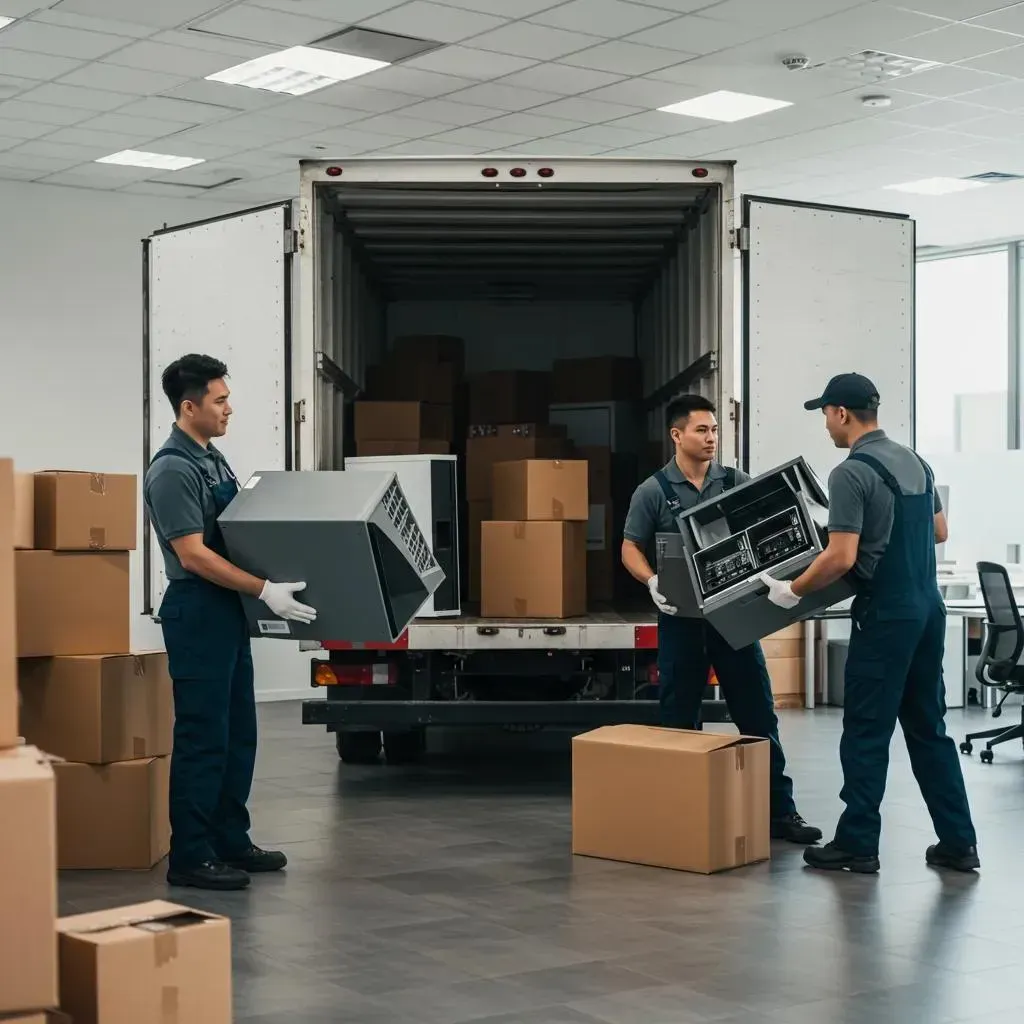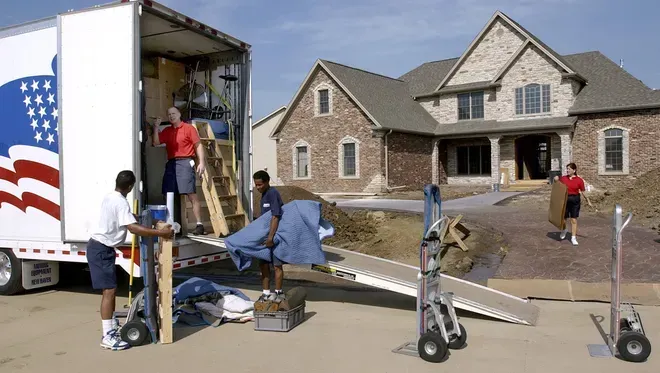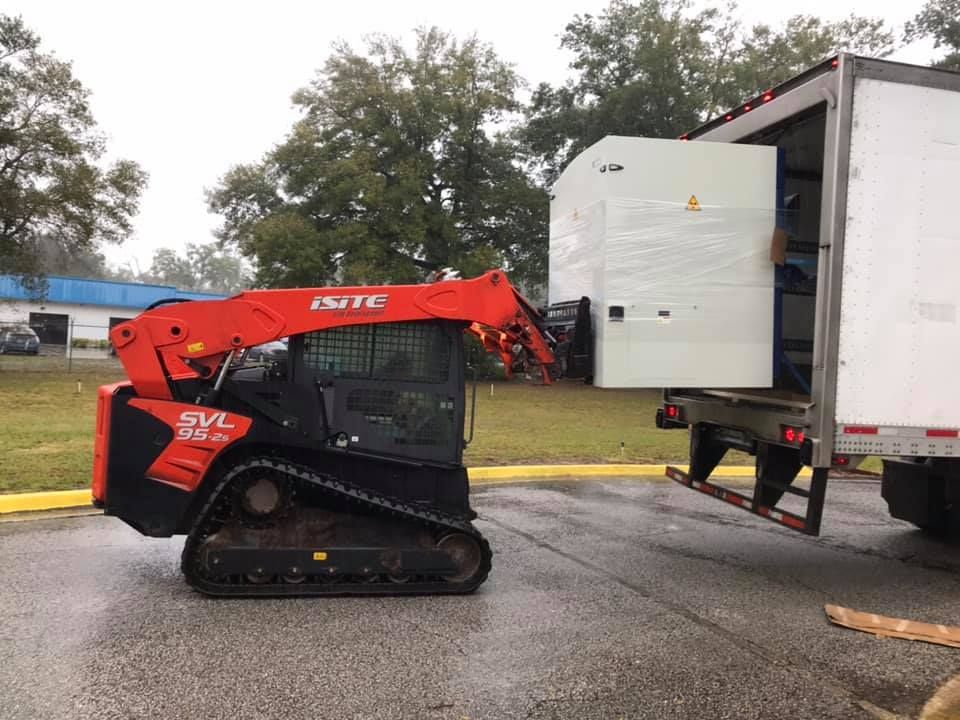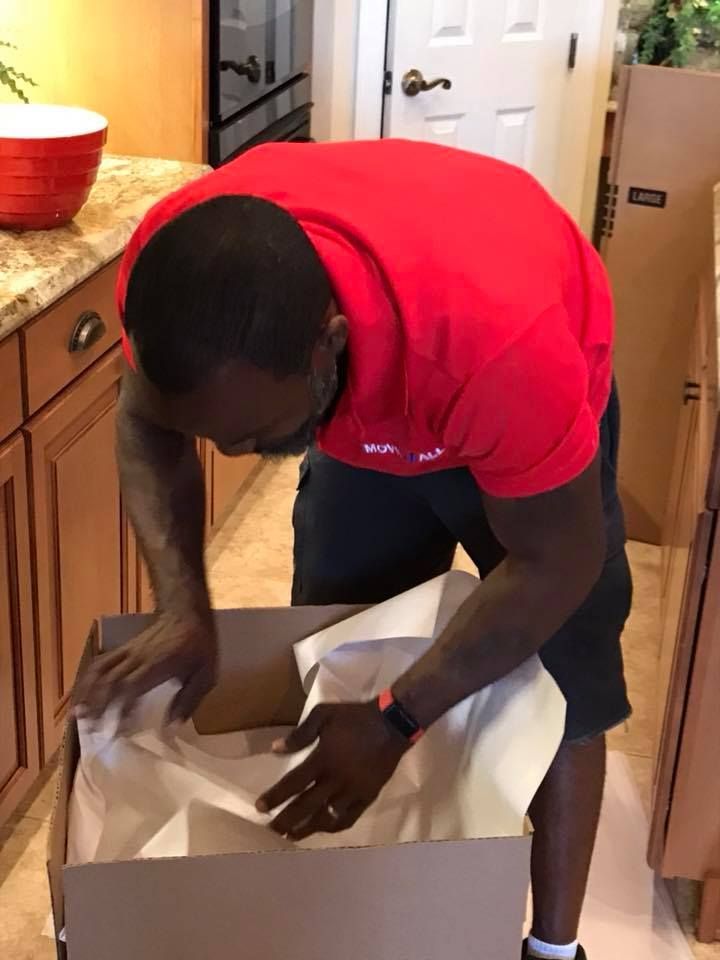BLOG
We Earned Their TRUST...
Now, Let Us Earn Yours!
Your Essential Commercial Moving Checklist: Plan and Execute a Seamless Office Relocation

A well-defined commercial moving checklist takes the guesswork out of your relocation, protecting your revenue by synchronizing your timeline, budget, and technical execution from the very start. This guide will walk business leaders through sequencing planning tasks, cataloging assets, coordinating IT migration, and managing moving day to minimize downtime and safeguard your valuable assets. Our checklist focuses on actionable steps—forming a moving committee, designing floor plans, tagging inventory, staging IT cutovers, and executing a safe day-of operation—to ensure your office relocation proceeds with predictable success. Businesses that adhere to a structured office relocation project plan significantly reduce lost productivity and costly mistakes. This article breaks down those actions into manageable months, weeks, and days. You'll find timelines tailored for small, medium, and large moves, operational logistics for 3–6 months out, preparation for packing and specialized equipment, final pre-move confirmations, day-of checklists, and post-move validation. Throughout, we've incorporated key phrases like "commercial moving checklist for businesses," "commercial moving timeline for businesses," "IT equipment moving checklist," and "minimizing business downtime during move" to help you translate strategy into concrete tasks. Practical lists, EAV tables, and recommended checkpoints make this a hands-on resource for any corporate move.
When Should You Kick Off Your Commercial Move Planning?
Planning a commercial move requires scheduling decisions months in advance to safeguard business continuity, prevent vendor delays, and secure necessary permits. Starting early allows you to align lease timelines, vendor lead times, and IT migration windows, ensuring the move causes minimal operational disruption. Early planning reduces risk and provides ample time to obtain accurate commercial moving quotes, confirm insurance, and develop contingency budgets. The following section outlines recommended lead times based on business size and the immediate first steps to initiate a structured relocation.
The ideal start time depends on complexity and risk. The table below provides practical ranges by business size and the typical initial actions to get started.
| Business Size | Recommended Lead Time | First Actions |
|---|---|---|
| Small office (1–25 staff) | 2–6 months | Define objectives, assign move manager, draft simple timeline |
| Medium office (26–100 staff) | 6–12 months | Conduct site visits, start procurement, issue vendor RFPs |
| Large enterprise (100+ staff / specialized equipment) | 12–18 months | Engage stakeholders, schedule IT migration planning, secure permits |
This comparison highlights how increased complexity necessitates longer lead times and why starting earlier provides a crucial buffer for specialized equipment, permitting, and staged moves. The next subsection delves into specific early timeline ranges and practical examples to help you establish your target planning window.
How Far in Advance Should Businesses Begin Their Relocation Planning?

Relocation planning commences once objectives, capacity, and constraints are clearly understood, and a move manager can be appointed to centralize decision-making. Begin with a high-level project plan that outlines major milestones—site selection, lease review, IT migration planning, and vendor selection—and assign ownership for each. Complex moves involving medical equipment, safes, or heavy machinery require additional permitting and specialist coordination, which naturally extends the lead time. Establishing this initial plan brings clarity to budgets and allows for early engagement with vendors who offer specialized equipment handling or commercial moving services. Proactive action prevents last-minute rushes and provides the necessary time to refine an office relocation project plan that aligns with your business cycles.
What Are the Key Strategic Steps 6-12 Months Before Your Move?
Six to twelve months prior to your move, transform objectives into binding tasks that minimize downstream surprises and secure essential procurement lead times. Key strategic steps include finalizing the new lease or space layout, developing a preliminary floor plan, obtaining vendor quotes, and creating a detailed budget with a built-in contingency. Initiate procurement for long-lead items such as custom furniture, phone systems, or specialized racks, and schedule their installation. Begin the vendor selection process for movers, IT service providers, and specialized equipment handlers; early engagement secures preferred dates and competitive pricing. These steps ensure you have a realistic timeline and a solid financial framework to guide the crucial 3–6 month operational logistics phase.
How Do You Form a Moving Committee and Assign Roles?
A moving committee fosters accountability and enables rapid decision-making throughout a relocation. It should comprise representatives from leadership, IT, facilities, HR, and operations. Typical roles include a Move Manager who oversees the schedule, an IT Lead responsible for cutovers, a Facilities Lead managing physical changes, and an Employee Communications lead. Utilize a simple RACI matrix to clarify responsibilities: determine who is Responsible, who is Accountable, who is Consulted, and who is Informed for each task. Regular meetings—biweekly in the early stages, weekly as the move approaches—keep stakeholders aligned and prevent miscommunication. A well-defined committee minimizes bottlenecks and ensures efficient escalation on the day of the move.
Why Is Budgeting Absolutely Crucial for Your Business Relocation?
Budgeting translates project intent into executable resources and safeguards against cost overruns by identifying both direct and indirect expenses. Major categories include mover fees, IT downtime and migration costs, new furniture and equipment, permits, and contingencies for unforeseen delays. Indirect costs—such as lost revenue or reduced productivity during downtime—must be estimated and mitigated through phased moves or overnight work. Require vendors to provide itemized bids and verify insurance coverage within the budget to cover specialized equipment transport. A disciplined budget framework maintains objective decision-making and supports contingency planning when scope changes arise.
How Do You Manage Detailed Logistics 3-6 Months Before the Move?
Logistics during the 3–6 month window transition planning into executable operations, including finalizing floor plans, conducting asset inventories, sequencing IT moves, and notifying vendors. Effective logistics identify physical constraints, define staging zones, and sequence moves to protect critical systems. Coordination among internal teams and vendors ensures that furniture disassembly and IT migration align with move-day crews and that specialized equipment receives the required handling. The steps below provide an operational roadmap to manage complexity and minimize surprises.
When preparing operational tasks, use the following prioritized logistics checklist to target featured snippet-style outcomes.
- Develop a finalized floor plan detailing workstation assignments, adjacencies, and circulation paths.
- Conduct a tagged inventory of all assets, including serial numbers, condition, and replacement value.
- Sequence IT and telecom migration, defining backup, disconnect, and reconnect windows.
- Notify employees, clients, and vendors with clear move communications and timelines.
- Order long-lead equipment and confirm installation dates with installers.
This ordered list provides a clear sequence to follow, enabling teams to coordinate concurrently while preserving essential dependencies. Next, an inventory EAV table summarizes common asset types, handling requirements, and estimated resources needed to inform crew sizing.
| Asset Type | Handling Requirement | Estimated Resources / Time |
|---|---|---|
| Desks & Cubicles | Disassembly, protective wrapping, reassembly | 1 crew per 15 stations; 15–30 minutes per station |
| Servers & Racks | Shutdown plan, labeled cabling, dedicated rack movers | IT lead + 2 technicians; 2–6 hours per rack |
| Medical / Industrial Equipment | Custom rigging, crating, certified handlers | Specialty crew; variable (requires site survey) |
This inventory table links asset categories to handling and resource needs, allowing you to plan crew size and scheduling accurately. Next, we explore floor-plan creation and practical layout tips that support operational flow.
How to Develop an Effective Floor Plan for Your New Office?
An effective floor plan balances workflow, adjacency, and safety by mapping roles to specific spaces and ensuring clear circulation paths that preserve productivity. Begin with programmatic needs: determine the number of workstations, private offices, collaboration spaces, and storage zones, then overlay HVAC, power, and access points. Consider furniture footprints and ADA compliance to maintain clear paths, and reserve staging areas for movers to load/unload without impeding operations. Use the floor plan to sequence furniture placement, enabling reassembly crews to follow a clear priority order. A well-designed layout reduces rework and supports faster occupant settling.
What Is the Best Way to Inventory Office Assets and Equipment?

Inventory accuracy hinges on consistent labeling, photographic records, and a central database that captures make, model, serial number, condition, and replacement value. Employ durable barcode or QR labels and a simple spreadsheet or asset-management tool to track status throughout the move. Photograph items before packing to document their condition for insurance and reconciliation purposes, and categorize assets into furniture, electronics, sensitive equipment, and consumables. This detailed inventory supports insurance valuation, prioritizes unpacking, and informs crew estimates. Accurate inventory significantly reduces the risk of loss and speeds up final sign-off.
How Should You Plan IT and Telecom Migration?
IT migration demands a phased plan that sequences backups, shutdowns, transport, and reconnection while minimizing downtime and preserving data integrity. Define priority systems and a cutover window, schedule full backups, and meticulously label all cabling and ports before disconnecting. Coordinate movers with IT teams to ensure servers are transported with dedicated handling and arrive ready for reinstallation. Establish rollback plans and test connectivity immediately upon reconnection so critical applications can resume quickly. Clear responsibility and precise timing reduce extended outages and keep teams productive.
When planning IT migration, consider engaging professional IT relocation guidance and coordinating with specialized equipment handlers for large servers and medical devices; vendors offering Specialized Equipment Handling can often provide critical coordination support.
Plan and Implement a Migration Strategy for Business Relocation
As we get into details of the process, specific techniques and technologies are “plugged in” at the right time to execute a particular step. The process is the same for every migration, but the exact execution may vary depending on the source systems, target systems, existing SLAs and workloads, and other variables that are outside our control. With a few exceptions, migrating to Azure is no more or less complicated than migrating all your database servers to another data center. Like any other large and complex IT task, we break it down into simpler phases and steps and execute them in order.
Plan and Implement a Migration Strategy, 2025
When and How Should You Notify Employees, Clients, and Vendors?
A staged communication plan keeps all stakeholders informed and minimizes confusion: provide an initial notice, send reminders at major milestones, and issue detailed move-day instructions. Tailor messages to each audience—employees receive move packets with personal workstation packing instructions, clients get service impact notices, and vendors receive updated delivery addresses and service windows. Utilize multiple communication channels—email, internal portal, and printed notices—to ensure broad reach and redundancy. Provide FAQs and a single point-of-contact for questions to prevent mixed messages. Early, clear communication reduces missed deliveries and service interruptions.
How to Update Business Information and Order New Equipment?
Administrative updates must be scheduled to align with move dates: change-of-address notifications with licensing bodies, vendors, bank records, and subscriptions are essential to avoid disruption. Order new furniture and long-lead equipment well in advance and confirm delivery and installation windows; custom furniture often requires weeks to months for delivery. Coordinate signage and external wayfinding to be ready upon occupancy and alert service providers to the exact move date. Confirm installers and schedule follow-up inspections to ensure your new space is fully operational on the first business day. These administrative steps finalize your operational readiness.
What Are the Best Practices for Preparation and Packing 1–2 Months Before Moving?
The 1–2 month window is when packing supplies are staged, sensitive documents secured, electronics prepared, and specialized equipment readied for transport. Thorough preparation reduces the risks of damage and data loss while ensuring labeled, prioritized unpacking at the destination. Professional packing can accelerate the process for critical assets and reduce the time staff must divert from their core business tasks. Below are practical steps for acquiring supplies, ensuring secure handling, and preparing equipment.
Begin by gathering packing materials and deciding which items to pack internally versus contracting out; the list that follows helps prioritize common supplies and decisions.
- Essential packing supplies include sturdy moving boxes, labeled bins, bubble wrap, furniture blankets, cable ties, and file cartons.
- Electronics protection supplies include anti-static bags, hard-shell cases for servers, and labeled power strips.
- Specialized equipment needs may require custom crating, palletization, and certified rigging services.
These categories help you order the correct materials and scope packing labor effectively. The next subsection covers acquiring supplies and the role professional packing services play.
How to Acquire Packing Supplies and Utilize Professional Packing Services?
Sourcing packing materials early prevents shortages and supports phased packing of nonessential items before move week. Order a variety of small, medium, and large boxes, along with specialty materials for fragile electronics and displays; maintain an inventory log of supplies consumed. Professional packing services reduce risk for high-value items and expedite loading, and they frequently provide immediate, free delivery of packing materials to job sites. Consider full or partial packing options based on staff availability and asset complexity. Outsourcing packing for electronics, archives, and sensitive equipment allows internal teams to focus on business continuity.
What Are the Steps to Secure Sensitive Documents and Office Electronics?
Securing sensitive documents begins with classification—identify records requiring chain-of-custody and those eligible for shredding—and proceeds to sealed, labeled boxes with restricted handling instructions. Electronics should be backed up, imaged, and shipped with labeled cabling and port documentation; remove batteries and secure loose parts. Use tamper-evident seals for high-risk items and maintain a manifest signed by responsible parties at each transfer point. Confirm secure transport protocols with movers for sensitive loads and retain contact details for escalation. These steps significantly lower the risk of data loss and protect compliance obligations.
How to Plan for Specialized Equipment Moving?
Specialized equipment—such as medical devices, safes, or industrial machinery—requires pre-move site surveys, certification checks, and sometimes permits or escorts. Create a detailed handling specification: include weight, dimensions, connection points, and any decontamination requirements, and procure custom crating or rigging as recommended. Verify mover qualifications for specialized equipment and confirm insurance limits for high-value transfers. Coordinate with facility teams at both locations to confirm crane access, door clearances, and staging areas. Proper planning prevents damage and ensures the safe transport of critical assets.
When specialized moves are part of your schedule, consider working with vendors who specialize in equipment handling to align rigging, insurance, and technical coordination.
When Should You Schedule Utility Disconnections and Reconnections?
Utilities and connectivity must be sequenced to minimize blackout periods: schedule HVAC, power, phone, internet, and security system cutovers with built-in buffers for testing. Notify providers at least two to four weeks in advance for standard services and earlier for complex installations or dedicated circuits. Arrange for temporary services, such as backup internet or power, if critical operations require continuous uptime during the transition. Confirm technicians’ arrival windows for reconnection and plan verification tests immediately upon activation. A coordinated utility schedule reduces unexpected downtime and speeds operational recovery.
How Do You Finalize Your Move 1–2 Weeks Before Moving Day?
One to two weeks out is the critical time to confirm all vendors, finalize schedules, distribute move packets, and conduct pre-move walkthroughs to align expectations. Final confirmations prevent last-minute scope changes and ensure teams are aware of staging zones, parking arrangements, and elevator reservations. A pre-move conference clarifies responsibilities and establishes an escalation path, ensuring the moving day proceeds smoothly. The short checklists below define what to confirm and how to prepare the old space for turnover.
Before reviewing the day-of tasks, confirm these core items with vendors and internal leads in writing.
- Arrival times and crew sizes for the moving company and any subcontractors.
- Final IT cutover schedule and on-site IT support assignments.
- Parking, loading dock reservations, and security passes for crews.
- Emergency contacts and the decision escalation chain.
This final confirmation list helps tighten loose ends and prepare for move week. The next subsections cover confirmations with movers, IT wrap-up, the pre-move conference, and preparing the old office.
What Should You Confirm with Your Commercial Moving Company?
Confirm the mover’s arrival time, crew size, equipment list, insurance coverage, and overnight procedures to ensure transparent expectations. Validate special handling needs for heavy or sensitive assets and request a final signed scope of work to prevent scope creep. Ask for contact details for onsite supervision and escalation, and confirm policies for delays and additional charges. Verify mover licensing and insurance certificates as part of the confirmation process and ensure a plan for overnight storage if required. Clear confirmations reduce disputes and ensure accountability.
MOVE IT ALL / Full Service Mover offers Commercial Moving Services that can be consulted early in the pre-move phase to confirm crew capabilities, insurance limits, and specialized equipment handling needs. Early consultation with a commercial mover reduces scheduling risk and helps align move-day sequencing.
How to Finalize IT Setup and Distribute Employee Move Packets?
Finalize IT cutover plans with detailed timelines for backups, shutdowns, transport, and validation tests, and create comprehensive employee move packets that include workstation responsibilities, packing instructions, and first-day procedures. Distribute packets via email and physical copies, and include a prioritized list of devices that require immediate reconnection. Arrange for on-site or remote IT support for the first 48–72 hours after the move to address configuration or access issues quickly. Clarity in move packets reduces confusion and accelerates business resumption.
Why Is Conducting a Pre-Move Conference So Important?
A pre-move conference aligns all stakeholders on the final plan, confirms responsibilities, and provides an opportunity to resolve potential conflicts before move day. Use the meeting to review the schedule, safety protocols, parking and elevator logistics, and contingency plans for weather or delays. Document all decisions in meeting minutes and circulate them to all parties so there is a single source of truth during execution. This meeting minimizes surprises and empowers crew leaders and internal points-of-contact to act decisively. A final alignment session is a low-effort, high-impact activity that prevents costly misunderstandings.
How to Prepare Your Old Office for the Move?
Preparing the old office involves cleaning, removal of signage, patching and repairs, and completing final walkthrough items required for lease turnover. Create a closing checklist that includes removal of personal items, final meter readings, waste disposal, and a signed key handover document. Photograph the space after cleaning to document its condition and retain copies for lease reconciliation. Coordinate final utility disconnections and confirm receipt of returned keys or access cards. A disciplined turn-back process reduces lease liability and accelerates deposit recovery.
What Are the Key Actions on Moving Day for a Smooth Execution?
Moving day demands clear roles, tight communication, and rapid reconciliation of inventory and systems to ensure operations resume quickly at the new site. On the day, a single point-of-contact should coordinate crews, manage staging, and confirm safety, while IT teams execute cutover sequences and test critical systems. The ordered checklist below captures top priorities to target featured snippets and ensure smooth execution.
- Assign a single point-of-contact and confirm the escalation path with all crews.
- Execute prioritized loading and verify inventory manifests during each load.
- Ensure the IT team begins immediate reconnection and performs smoke tests.
- Monitor safety, traffic flow, and staging zones to prevent bottlenecks.
- Conduct an initial walkthrough at the destination to verify key spaces.
- Sign off on completed zones and update the master status board.
This checklist prioritizes coordination and immediate functional tests, enabling your business to begin recovery as soon as items are in place. An on-site EAV table below outlines day-of tasks, responsibilities, and completion checks for quick reference.
| Task | Responsible Party | Completion Check |
|---|---|---|
| Crew arrival & staging | Move Manager | Check-in roster signed |
| Inventory reconciliation | Moves Supervisor | Manifest signed per truck |
| IT reconnection & testing | IT Lead | Network and phone smoke tests passed |
| Final walkthrough & sign-off | Facilities Lead | Zone sign-off completed |
The table clarifies who owns each deliverable and provides a concise verification mechanism to reduce ambiguity. The next sections explain how to coordinate on-site activities, complete walkthroughs, and ready IT teams for immediate setup.
How to Coordinate On-Site Activities with Your Moving Team?
Coordination requires a clear communication plan with designated radio channels, staging maps, and colored labels for zones to prevent misrouting. Establish staging areas for incoming trucks, assemble a master whiteboard listing priorities, and ensure one person manages crew assignments and traffic flow. Use labeled pathways and protective floor coverings in high-traffic areas to prevent damage during moves. Confirm safety protocols and provide a brief safety orientation to all incoming personnel. A proactive staging strategy prevents delays and injuries.
What Is the Process for Final Walkthrough and Inventory Checks?
Final walkthroughs follow a zone-by-zone approach where a responsible party inspects items against the inventory manifest and records discrepancies for immediate resolution. Use signed manifests and photographs to document condition and ensure that any damage claims are supported by evidence. Log missing items with timestamps and responsible crew details to track resolution efforts. After each zone is verified, obtain sign-off and update the master status board to reflect progress. Systematic walkthroughs make reconciliation transparent and defensible.
How to Ensure IT Teams Are Ready for Immediate Setup?
Prepare IT teams with a prioritized device list, labeled cabling, and pre-staged racks to reduce reconnection time, and schedule network smoke tests immediately after power is restored. Ensure backup systems are accessible and have spare hardware available for rapid replacement if components fail. Assign clear responsibilities for server, network, and workstation verification and maintain a live issue log for rapid escalation. Confirm that service providers for internet and phone are on standby for any last-mile issues. Effective IT readiness recovers critical services and minimizes downtime.
How Do You Integrate and Review Your New Office Post-Move?
Post-move integration focuses on prioritized unpacking, systems testing, employee onboarding in the new space, and collecting feedback to refine layout or processes. Establish unpacking priorities—critical IT, shared spaces, and then individual workstations—to get the business functional quickly. Perform system tests across network, phones, HVAC, and specialized equipment, and document pass/fail criteria. Gathering employee feedback surfaces issues that may seem minor but are impactful, enabling quick adjustments that improve productivity. The following subsections outline unpacking priorities, testing protocols, feedback collection, and celebration actions to close the project positively.
What Are the Best Practices for New Office Setup and Organization?
Prioritize unpacking by function: get IT and shared spaces operational first, then distribute supplies and finalize individual workstations. Use clear labeling so supplies and small parts reach their intended owners and avoid repeated searches. Establish temporary storage for overflow items and slow-moving boxes to prevent clutter in primary work areas. Adjust furniture placement after initial use to refine ergonomics and workflow. A staged unpack approach returns staff to productive work faster.
How to Test All Systems and Equipment After the Move?
Systematic testing begins with network and phone systems, followed by security and HVAC checks, and concludes with calibration or vendor verification for specialized equipment. Use predefined pass/fail criteria and sign-off authorities for each system to ensure accountability. Maintain a checklist that lists tests, results, and resolution owners, and schedule vendor follow-ups for any failing items. Testing validates readiness and reduces latent faults that can disrupt operations later. A documented test protocol ensures you can resolve issues methodically.
Why Is Gathering Employee Feedback So Important After Relocation?
Employee feedback identifies ergonomic issues, missing supplies, and workflow bottlenecks that leaders may not observe from a high level. Use short surveys and targeted focus groups to collect prioritized issues and then categorize fixes by business impact and effort required. Communicate the planned resolution timeline so staff feel heard and see progress. Feedback-driven tweaks often yield significant morale and productivity gains after relocation. Listening completes the move and helps institutionalize lessons learned.
How to Celebrate and Communicate the Successful Move?
Recognize the team and communicate the new address and service availability to clients with an announcement that highlights readiness and operational improvements. Small celebrations and thank-you notes energize staff and acknowledge the extra effort required during the move. Update external stakeholders via formal notices and ensure signage and online listings reflect the new location. Celebrating demonstrates closure and reinforces a positive transition for internal and external audiences.
What Are Common Questions About Commercial Moving?
Common questions focus on timing, downtime minimization, vendor selection, planning timeframes, and insurance verification; clear, direct answers help decision-makers move forward confidently. Below are concise answers that address typical concerns and help teams decide on next steps when evaluating a commercial move. Each response provides a practical guideline or decision framework for managers.
What Is the Best Time to Plan a Commercial Move?
Plan a commercial move between 6 and 18 months in advance, depending on complexity and scale; simple small-office relocations can begin 2–6 months out, while enterprise or specialized equipment moves should start 12–18 months ahead. Early planning creates the necessary space to align budgets, permits, and long-lead procurement and helps avoid seasonal vendor bottlenecks. If you face lease deadlines or rapid growth, accelerate decision-making and prioritize vendor engagement to secure required resources. Starting with a realistic planning window reduces last-minute costs.
How Can You Minimize Business Downtime During a Move?
Minimize downtime by utilizing phased moves, scheduling overnight or weekend moves for critical systems, and pre-staging equipment and furniture so only minimal on-site reconfiguration is needed during operating hours. Coordinate IT cutovers during off-peak windows and prepare rollback plans to restore services quickly if issues arise. Engage professional movers experienced in corporate relocations who can execute rapid, documented transfers and provide staging solutions. Applying these tactics preserves revenue and customer service continuity.
Do You Need to Hire Professional Movers for Your Business Relocation?
Professional movers are highly recommended when complexity, asset value, or downtime risk exceeds internal capacity; they bring trained crews, specialized equipment, and liability coverage to manage heavy lifts and specialized handling. Use a decision checklist: assess internal staffing capabilities, specialized equipment needs, insurance requirements, and acceptable downtime. Professional Commercial Moving Services handle logistics, packing, and crew coordination, significantly reducing the risk of damage and delays. For many organizations, the cost of professionals is justified by faster, safer execution and lower indirect costs.
To request professional assistance, consider MOVE IT ALL / Full Service Mover’s Commercial Moving Services, which include specialized handling, packing options, and insured transport; contact details for scheduling an estimate are available through their business contact channels.
How Long Does It Typically Take to Plan an Office Move?
Typical planning timelines vary: small moves often require 2–6 months, medium moves 6–12 months, and large or specialized moves 12–18 months, with key milestones at 6–12 months, 3–6 months, and 1 month out. Each phase has specific deliverables—site planning, vendor selection, operational logistics, and final confirmations—that structure the schedule and make progress measurable. Compressed timelines force parallel work and higher contingency budgets; realistic scheduling reduces both cost and risk. Use milestone reviews to keep the plan on track.
What Are the Insurance Requirements for Commercial Moving?
Commercial moving insurance should cover transit damage, general liability, and specific coverage for high-value or specialized equipment; verify mover certificates and limits before contracting. Confirm valuation options and request proof of coverage and endorsements for unique risks such as medical devices or safes. Move managers should retain photographic inventories and signed manifests to support claims if needed. MOVE IT ALL is presented as fully licensed and insured with coverage up to $3 million, which provides a quantifiable trust signal when evaluating movers and verifying insurance sufficiency.
This set of practical answers should guide your next steps and help you decide when to engage professional services or initiate internal planning teams. For a formal quote or to discuss Commercial Moving Services and specialized handling requirements, use the company contact details in your vendor selection process to request an estimate and coordinate a site survey using the contact information you maintain for prospective vendors.
Frequently Asked Questions
What are the common challenges businesses face during a commercial move?
Common challenges during a commercial move include managing timelines, coordinating with multiple vendors, and ensuring minimal disruption to operations. Businesses often struggle with unexpected delays, miscommunication among teams, and the complexity of IT migration. Additionally, accurately budgeting for both direct and indirect costs can be difficult, leading to financial strain. To mitigate these challenges, it's essential to have a well-structured plan, a dedicated moving committee, and clear communication channels established well in advance of the move.
How can businesses ensure the safety of sensitive data during a move?
To ensure the safety of sensitive data during a move, businesses should implement a comprehensive data protection strategy. This includes backing up all critical data before the move, using encryption for data in transit, and labeling all cables and devices clearly. Additionally, sensitive documents should be securely packed and transported with restricted access. Engaging professional movers experienced in handling IT equipment can further enhance security, as they are familiar with best practices for protecting sensitive information during relocation.
What role does employee communication play in a successful office move?
Employee communication is crucial for a successful office move as it helps to manage expectations and reduce anxiety among staff. Clear communication about timelines, packing responsibilities, and new office layouts ensures that employees are prepared and informed. Providing move packets with detailed instructions and updates fosters a sense of involvement and ownership. Regular updates through various channels, such as emails and meetings, can also help address concerns and keep everyone aligned, ultimately leading to a smoother transition.
How can businesses handle unexpected issues on moving day?
Handling unexpected issues on moving day requires a proactive approach and a well-defined contingency plan. Establishing a single point of contact to coordinate activities can streamline communication and decision-making. It's essential to conduct a pre-move conference to clarify roles and responsibilities, ensuring everyone knows the escalation path for issues. Having backup plans for potential problems, such as delays in vendor arrivals or equipment malfunctions, can help mitigate disruptions. Flexibility and quick problem-solving are key to maintaining momentum during the move.
What are the benefits of hiring professional movers for a commercial relocation?
Hiring professional movers for a commercial relocation offers several benefits, including expertise in logistics, specialized equipment handling, and reduced risk of damage. Professional movers are trained to manage complex moves efficiently, ensuring that timelines are met and operations resume quickly. They also provide insurance coverage, which protects against potential losses during transit. Additionally, outsourcing the moving process allows internal teams to focus on their core responsibilities, minimizing disruption to business operations and enhancing overall productivity during the transition.
How can businesses evaluate the effectiveness of their move post-relocation?
To evaluate the effectiveness of a move post-relocation, businesses should conduct a thorough review of the entire process. This includes gathering feedback from employees about their experiences, assessing the functionality of the new space, and analyzing any disruptions to operations. Key performance indicators, such as downtime, employee satisfaction, and budget adherence, can provide valuable insights. Additionally, documenting lessons learned and areas for improvement can help refine future relocation strategies and enhance overall organizational resilience.
Conclusion
Implementing a comprehensive commercial moving checklist ensures a smooth transition by aligning timelines, budgets, and operational logistics, ultimately safeguarding productivity. By following structured planning and execution, businesses can minimize downtime and avoid costly oversights during their relocation. To further streamline your move, consider consulting with professional movers who specialize in commercial relocations. Explore our services today to ensure your office move is efficient and successful.













